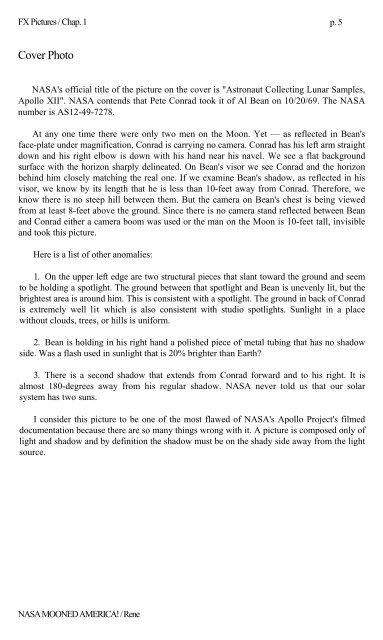Rene-NASA-Mooned-America
Rene-NASA-Mooned-America
Rene-NASA-Mooned-America
You also want an ePaper? Increase the reach of your titles
YUMPU automatically turns print PDFs into web optimized ePapers that Google loves.
FX Pictures / Chap. 1 p. 5<br />
Cover Photo<br />
<strong>NASA</strong>'s official title of the picture on the cover is "Astronaut Collecting Lunar Samples,<br />
Apollo XII". <strong>NASA</strong> contends that Pete Conrad took it of Al Bean on 10/20/69. The <strong>NASA</strong><br />
number is AS12-49-7278.<br />
At any one time there were only two men on the Moon. Yet — as reflected in Bean's<br />
face-plate under magnification, Conrad is carrying no camera. Conrad has his left arm straight<br />
down and his right elbow is down with his hand near his navel. We see a flat background<br />
surface with the horizon sharply delineated. On Bean's visor we see Conrad and the horizon<br />
behind him closely matching the real one. If we examine Bean's shadow, as reflected in his<br />
visor, we know by its length that he is less than 10-feet away from Conrad. Therefore, we<br />
know there is no steep hill between them. But the camera on Bean's chest is being viewed<br />
from at least 8-feet above the ground. Since there is no camera stand reflected between Bean<br />
and Conrad either a camera boom was used or the man on the Moon is 10-feet tall, invisible<br />
and took this picture.<br />
Here is a list of other anomalies:<br />
1. On the upper left edge are two structural pieces that slant toward the ground and seem<br />
to be holding a spotlight. The ground between that spotlight and Bean is unevenly lit, but the<br />
brightest area is around him. This is consistent with a spotlight. The ground in back of Conrad<br />
is extremely well lit which is also consistent with studio spotlights. Sunlight in a place<br />
without clouds, trees, or hills is uniform.<br />
2. Bean is holding in his right hand a polished piece of metal tubing that has no shadow<br />
side. Was a flash used in sunlight that is 20% brighter than Earth<br />
3. There is a second shadow that extends from Conrad forward and to his right. It is<br />
almost 180-degrees away from his regular shadow. <strong>NASA</strong> never told us that our solar<br />
system has two suns.<br />
I consider this picture to be one of the most flawed of <strong>NASA</strong>'s Apollo Project's filmed<br />
documentation because there are so many things wrong with it. A picture is composed only of<br />
light and shadow and by definition the shadow must be on the shady side away from the light<br />
source.<br />
<strong>NASA</strong> MOONED AMERICA! / <strong>Rene</strong>


